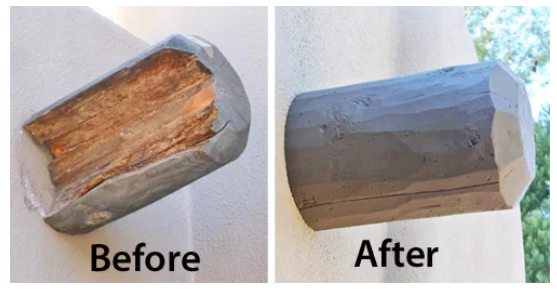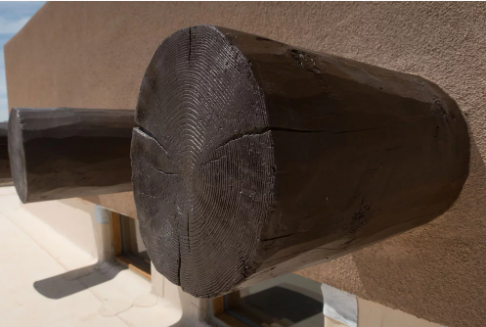For homeowners of Pueblo- and Santa Fe-style homes, the iconic viga is more than just an architectural feature — it’s a defining element of the design. These peeled logs, often protruding from stucco walls, give homes their unique Southwestern charm.
A viga is a small portion of a round log that has one of two purposes. It either supports the roof structure or is purely decorative. Traditional Santa Fe- or Pueblo-style homes often feature these logs protruding from exterior stucco walls, creating a rustic, handcrafted look.

The vigas come in dark brown and medium pine. Custom colors are also available.
Unfortunately, wood is vulnerable. Over time, it deteriorates due to factors such as sun exposure, rain, termites and temperature fluctuations. This wear leads to potentially hazardous situations, including falling vigas, rot infiltration into stucco and drywall, and a near-constant need for maintenance.
Old, decaying wood vigas can be a hazard to people and property for two main reasons. They can split and fall to the ground without notice, potentially hurting someone or their pet or damaging a vehicle.
People are also reading…
Getting up on a high ladder to apply caulk or sealer to an aging viga is complex, cumbersome and potentially dangerous,
Replacing older vigas
Some homeowners, faced with the expense or effort of replacing old vigas, opt to remove them entirely and stucco over the holes. While this solves the maintenance issue, it dramatically changes the home’s aesthetic — often in a negative way.
Most homeowners choose not to use this option. It dramatically changes the appearance of the home and is not usually considered an improvement.
There are products on the market that cover the viga with protective materials like urethane foam, fiberglass or plastic-coated wood to extend their life. They often don’t look real, and some are more durable than others.
Other solutions
One attractive solution is to cap the viga with a fitted piece of copper or other metal. This works well if the deterioration is minimal.
But if you want to keep the wood look, Rosie on the House Certified Partner Fiberspan Vigas are the most realistic viga replacement product we have seen. They are warranted for as long as the homeowner owns the home.

ABOVE: The before and after look of vigas with Fiberspan. RIGHT: The Fiberspan vigas come in dark brown and medium pine. Custom colors are also available.
These vigas are the brainchild of Philip Bigleow, who initially created them as a DIY solution for a project for a home in Lake Montezuma, Arizona.

The Fiberspan vigas come in dark brown and medium pine. Custom colors are also available.
Fiberspan Vigas cover the original viga of the home. Castings are made from a reinforced cementitious composite. They weigh about the same as real wood, which makes them easy to lift and install. But unlike wood, they’ll never rot, warp, or split — no caulking, sealing or repainting required.
To capture and produce vigas that look real, Bigelow and his team start by making a flexible rubber mold over an actual wood viga. The rubber is applied in layers over multiple days until a proper thickness is achieved. After the rubber mold is dry, a hard mold (what they call a mother mold) is then made over the rubber mold to create support for the flexible rubber mold. Once the mold is complete, it’s removed from the wood viga (prototype).

Matching scuppers are also available to help keep the Southwest style.
“First, the rigid mother mold is pulled from the rubber mold, and then the rubber mold is peeled away from the wood viga,” Bigelow said. “We are left with a mold that has picked up every detail of that wood viga. Even the tiniest chip, wood grain, and nuance is replicated with this method.”
Fiberspan offers standard color choices in dark brown and medium pine, both designed to mimic popular wood finishes. However, if you’re going for a specific look, custom colors are available. Just provide a color code, and Fiberspan will match it, ensuring the new vigas blend seamlessly with your home’s existing aesthetic.
The company also manufactures canales, which are traditional roof scuppers used to drain water from flat roofs — another essential feature in Southwestern architecture. Faux headers are also available to complete the look of a classic Santa Fe home.
Just like their vigas, these elements are built to last and require no ongoing upkeep.
And unlike solid concrete, which can be heavy and unwieldy, Fiberspan’s hollow design ensures a manageable weight without compromising on strength. That makes installation easier for both contractors and DIY homeowners.
Replacing old vigas with Fiberspan allows homeowners to retain the beauty of their home’s traditional design without the downside of future repairs.
The top stories from Sunday's Home+Life section in the ĂŰĚŇÓ°ĎńAV.
“Fiberspan Concrete Vigas are the last vigas a homeowner will ever buy,” Bigelow pledges. “They will never have to climb on unsafe ladders to caulk or paint ever again.”








